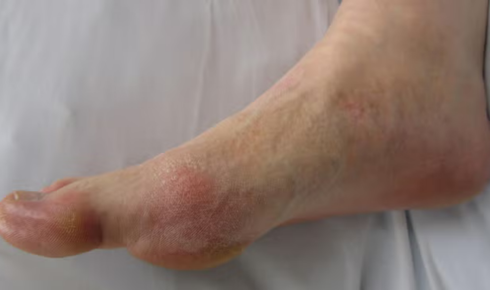Foot pain from gout is like an unwanted guest—it arrives unexpectedly and overstays its welcome. But imagine telling that pain goodbye and regenerating healthier foot tissues. Today’s gout doctors aren’t just treating symptoms; they’re rebuilding damaged joints with advanced regenerative techniques.
What Foot Regeneration Means in Modern Gout Management
Foot regeneration is more than pain relief—it’s about helping the foot heal itself naturally. Modern gout management goes beyond medications, embracing therapies that promote the body’s own ability to regenerate damaged tissues. Instead of masking symptoms, regeneration focuses on repairing and restoring joints and tissues affected by gout.
In practice, foot regeneration means gout doctors can now target the exact areas of inflammation and damage. They use techniques like platelet-rich plasma (PRP) and stem cell therapy to accelerate healing at the cellular level. For patients searching “gout specialist near me,” regenerative methods offer hope for lasting relief, reducing dependence on pain medications and potentially avoiding invasive surgeries.
How Regenerative Therapies Restore Joint Functionality
Regenerative therapies help joints work again by kick-starting the body’s repair processes. Treatments like PRP involve drawing a patient’s blood, concentrating the platelets, and injecting them into the damaged area. This floods the joint with growth factors, prompting new tissue growth and healing inflammation naturally.
Stem cell therapies go a step further, introducing specialized cells that can transform into healthy cartilage, bone, or ligament cells. For gout patients dealing with persistent joint pain, these therapies help restore mobility, reduce swelling, and improve overall function without the downtime and risks of surgery. A gout doctor near you trained in regenerative techniques can help patients regain the comfort and confidence to move freely again.
Origin and Science Behind Foot Tissue Renewal
Foot regeneration isn’t magic; it’s grounded in solid science. The approach harnesses the body’s natural healing processes, particularly through the use of adult stem cells and platelet-rich plasma. Adult stem cells are special because they can adapt and become any type of cell the body needs—cartilage, bone, or muscle—making them perfect for repairing foot joints damaged by gout.
The discovery that platelets in blood contain growth factors capable of healing tissues opened the door to new treatments. Platelets don’t just stop bleeding; they initiate the repair process by attracting healing cells and stimulating tissue growth. Gout doctors now leverage this biological mechanism to tackle stubborn pain and inflammation, renewing damaged tissues right at the source.
What Your Gout Specialist Does During a Regeneration Session
During a regeneration session, the gout specialist carefully assesses the affected foot to pinpoint exactly where injections are needed. First, they’ll draw a small amount of blood if using PRP, spin it in a centrifuge to separate the platelets, and then precisely inject the platelet-rich solution into the affected joint or tissues. For stem cell procedures, cells might be harvested from the patient’s own bone marrow or fatty tissue, prepared, and injected in a similar manner.
The procedure typically takes less than an hour and is done right in the specialist’s office. Comfort is prioritized, with local anesthesia used to minimize discomfort. Patients who look for a “gout doctor near me” using regenerative methods often appreciate the convenience and low stress of these minimally invasive procedures.
Key Benefits of Cellular-Based Foot Repair for Gout Sufferers
Cellular-based foot repair brings significant advantages to those suffering from chronic gout. One major benefit is lasting pain relief without relying heavily on drugs that can have unwanted side effects. Because treatments stimulate actual tissue repair, patients experience genuine improvement rather than temporary relief.
Another benefit is improved joint mobility. Many gout patients struggle with stiffness and limited motion in their toes and ankles. Regenerative techniques encourage new tissue growth, reducing stiffness and increasing flexibility. Over time, patients often find themselves able to resume favorite activities without the pain and limitation that once held them back.
What Recovery Looks Like After Regenerative Foot Treatments
Recovery after regenerative treatments is generally straightforward and much quicker than traditional surgical approaches. Initially, patients might experience mild soreness or swelling at the injection site, but this usually resolves within a few days. Doctors often recommend rest and limited activity for a brief period to give the cells and tissues time to establish and begin the repair process effectively.
Most patients see noticeable improvements within weeks, though continued healing occurs over several months as new tissues gradually strengthen. Follow-up visits with a gout specialist ensure that healing progresses smoothly. The absence of prolonged downtime means patients can often return quickly to everyday life, enjoying the benefits of reduced pain and better mobility.
Conditions Your Gout Doctor Can Address Through Regeneration
Regenerative foot treatments address more than gout alone. Specialists also successfully treat related conditions, such as arthritis, plantar fasciitis, tendonitis, and joint degeneration. Chronic foot pain caused by damaged tissues or inflammation responds exceptionally well to regenerative techniques, making these therapies versatile tools in a gout specialist’s toolkit.
Doctors often recommend regenerative treatments for conditions that haven’t improved with traditional therapies or for patients wanting to avoid invasive surgical options. By stimulating the body’s natural repair mechanisms, regenerative methods offer relief across multiple conditions. Patients searching online for “foot regeneration” and “gout specialist near me” discover that these advanced treatments provide hope, healing, and renewed foot health.




